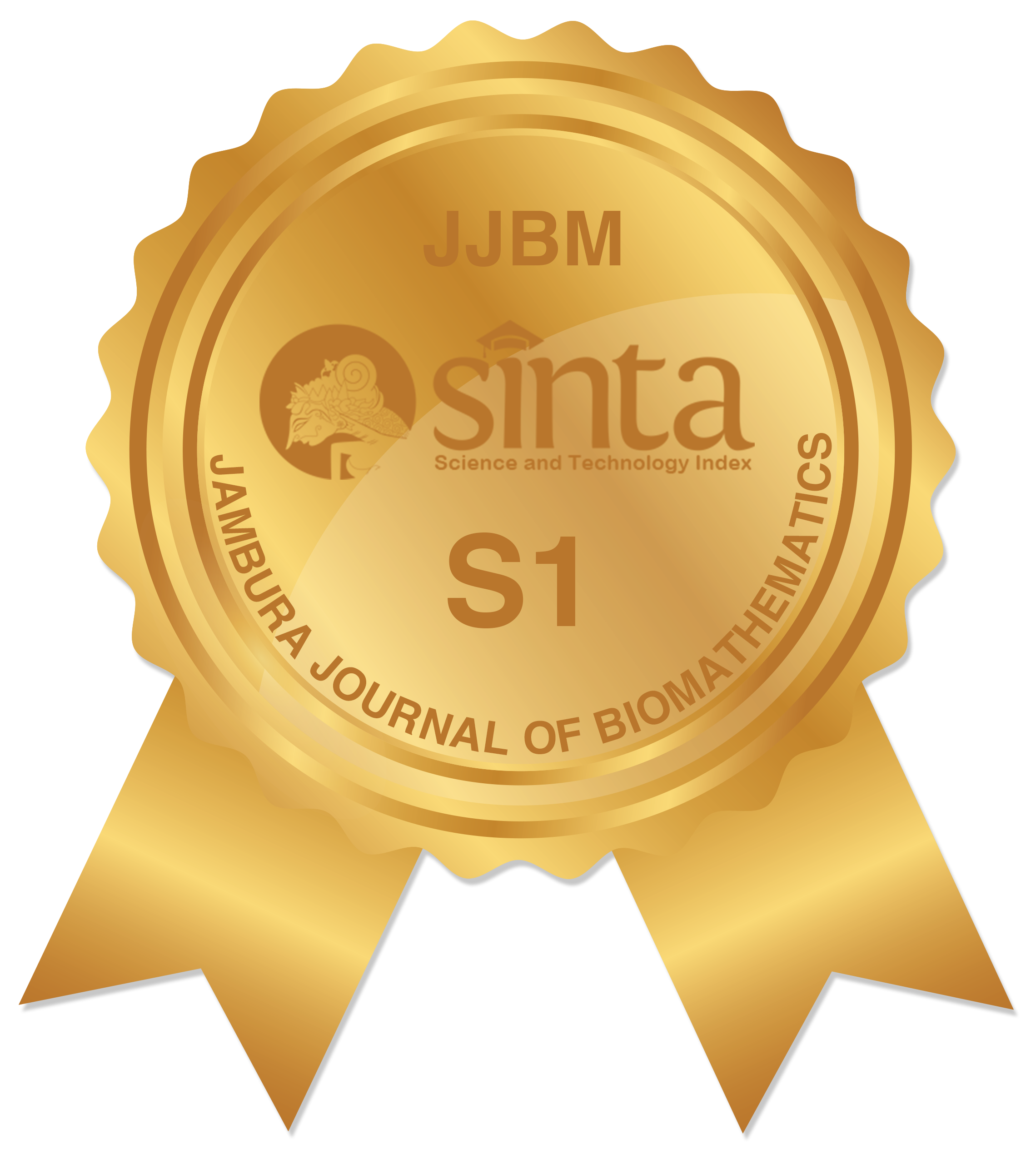Author Guidelines
Manuscript Submission
Jambura Journal of Biomathematics (JJBM) aims to become the leading journal in Southeast Asia in presenting original research articles and review papers about mathematical approaches to explain biological phenomena. JJBM will accept high-quality articles utilizing mathematical analysis to gain biological understanding in the fields of, but not restricted to:
Ecology
Mathematics is crucial in solving ecological problems by providing tools to quantify, model, and analyze complex ecological systems. Differential equations, probability theory, statistics, and optimization methods are commonly used mathematical frameworks in ecological research. These tools allow ecologists to develop models that describe population dynamics, species interactions, ecosystem processes, and the effects of environmental factors. By calibrating these models with empirical data, researchers can make predictions about the behavior of ecological systems under different scenarios, assess the impacts of human activities such as habitat destruction or climate change, and design effective conservation and management strategies. Moreover, mathematical techniques help synthesize large datasets, identify patterns and trends, and uncover underlying mechanisms governing ecological phenomena, thereby advancing our understanding of the natural world and informing decision-making for sustainable environmental stewardship.
Oncology
Mathematics is critical in tackling oncological problems by providing powerful analytical and computational tools to understand cancer biology, predict tumor behavior, optimize treatment strategies, and assess therapeutic outcomes. Mathematical modeling allows researchers to describe the complex dynamics of tumor growth, invasion, and metastasis and the interactions between cancer cells, the immune system, and the tumor microenvironment. Differential equations, agent-based models, network theory, and machine learning techniques are commonly employed to simulate these processes and predict how tumors evolve over time, respond to treatments, and develop resistance mechanisms. Mathematical models also aid in the design and optimization of treatment protocols, such as chemotherapy schedules, radiation dosing, and immunotherapy strategies, by predicting their efficacy and potential side effects. Moreover, mathematical approaches facilitate the analysis of large-scale genomic, proteomic, and clinical datasets, helping identify biomarkers for early detection, prognosis, and personalized treatment planning. By integrating mathematical and computational methods with experimental and clinical data, oncologists can gain deeper insights into cancer biology, improve patient outcomes, and accelerate the development of innovative therapies toward more effective cancer management.
Neurobiology
Mathematics is fundamental in understanding neurobiology, providing tools for modeling the complex structure and dynamics of the nervous system, analyzing experimental data, and making predictions about neuronal function and behavior. Mathematical modeling techniques, including differential equations, stochastic processes, and computational simulations, are used to describe the biophysical properties of neurons, the dynamics of neural networks, and the mechanisms underlying neural coding and information processing. For example, mathematical models can simulate action potential generation, synaptic transmission, and synaptic plasticity, shedding light on how neurons communicate and form functional connections. Network theory and graph theory are employed to study neural circuit organization and connectivity patterns, revealing principles of brain architecture and information flow. Furthermore, mathematical approaches are crucial for analyzing neuroimaging data, such as functional magnetic resonance imaging (fMRI) and electroencephalography (EEG), enabling researchers to map brain activity, identify brain regions involved in specific tasks or cognitive functions, and investigate brain disorders. By integrating mathematical modeling with experimental techniques, neurobiologists can uncover the underlying principles of brain function and dysfunction, leading to insights into neurological diseases, the development of therapeutic interventions, and the design of brain-inspired artificial intelligence systems.
Cell Biology
Mathematics is indispensable in understanding the behavior and dynamics of biological cells, offering tools to model cellular processes, analyze experimental data, and make predictions about cellular behavior under different conditions. Mathematical models of cellular processes range from simple biochemical reactions to complex systems involving gene regulation, signal transduction, and metabolic pathways. These models often employ ordinary, partial, and stochastic processes to describe the kinetics and interactions of biomolecules within the cell. For instance, mathematical models can elucidate how genes are regulated, how proteins interact to form cellular structures, and how signaling pathways mediate cellular responses to external stimuli. Moreover, mathematical approaches are crucial for analyzing experimental data generated from techniques such as microscopy, flow cytometry, and molecular biology assays, enabling researchers to extract quantitative information about cellular properties, dynamics, and functions. Mathematical modeling also facilitates designing and optimizing genetic circuits, synthetic biology constructs, and drug delivery systems, with applications in biotechnology and medicine. By integrating mathematical modeling with experimental biology, researchers can gain deeper insights into the complexity of cellular systems, uncover emergent properties, and address fundamental questions in cell biology, ultimately leading to advancements in healthcare, biotechnology, and our understanding of life itself.
Biostatistics
Mathematics is extensively applied in biostatistics, serving as the foundation for statistical methods used to analyze biological and medical data, draw meaningful inferences, and make informed decisions in healthcare and biomedical research. Mathematical concepts such as probability theory, calculus, and linear algebra underpin statistical techniques employed in biostatistics, including hypothesis testing, regression analysis, survival analysis, and experimental design. These methods are used to analyze various data types, including clinical trials, epidemiological studies, genomic data, and imaging data, to uncover patterns, trends, and associations related to disease risk, treatment effectiveness, and population health. Furthermore, mathematical modeling plays a crucial role in biostatistics, enabling the development of mathematical models that describe the dynamics of infectious diseases, population dynamics, and the spread of epidemics. These models help forecast disease outbreaks, evaluate public health interventions, and inform healthcare policies. Additionally, mathematical techniques are essential for assessing the reliability and validity of research findings, estimating sample sizes, and controlling for confounding factors in observational studies. Mathematics provides the theoretical framework and analytical tools necessary for biostatisticians to address complex biological and medical questions, contributing to advancements in healthcare, disease prevention, and medical decision-making.
Bioinformatics
Mathematics plays a crucial role in bioinformatics, providing the foundation for computational methods to analyze biological data, decipher genomic information, and understand the structure and function of biological molecules. Mathematical concepts such as algorithms, probability theory, graph theory, and linear algebra are extensively applied in bioinformatics to develop computational tools and models for analyzing DNA sequences, protein structures, and biological networks. Sequence alignment algorithms, such as dynamic programming and hidden Markov models, compare DNA, RNA, and protein sequences, reveal evolutionary relationships, identify functional elements, and predict gene functions. Mathematical techniques like machine learning and pattern recognition are employed to classify biological sequences, predict protein structures, and annotate genomic data. Furthermore, mathematical modeling is essential for simulating biological processes, such as gene regulation, metabolic pathways, and protein-protein interactions. It enables researchers to gain insights into complex biological systems and predict their behavior under different conditions. Mathematical approaches are also crucial for analyzing high-throughput data generated from techniques like next-generation sequencing, microarrays, and mass spectrometry, facilitating the discovery of biomarkers, drug targets, and disease mechanisms. By integrating mathematics with biology and computer science, bioinformatics enables researchers to harness the vast amounts of biological data available today, accelerating discoveries in genomics, personalized medicine, and biotechnology and ultimately improving human health.
Bio-engineering
Mathematics is essential in bioengineering, providing the quantitative framework for designing, analyzing, and optimizing biological systems and biomedical devices. Mathematical modeling describes the physical and biochemical processes underlying biological systems, such as tissue growth, gene expression, and drug kinetics. Differential equations, partial differential equations, and stochastic processes are commonly used to represent these processes, enabling researchers to simulate and predict the behavior of engineered biological systems. Mathematical optimization techniques are utilized to design and optimize biomedical devices and therapies, such as artificial organs, prosthetic limbs, and drug delivery systems, by maximizing performance metrics while minimizing adverse effects. Moreover, mathematical approaches are crucial for analyzing experimental data generated from biological experiments and clinical trials, allowing researchers to extract meaningful insights, identify trends, and make informed decisions. Additionally, mathematical modeling and simulation are employed to guide the development of medical imaging techniques, such as MRI, CT, and PET scans, enabling clinicians to visualize and diagnose diseases non-invasively. By integrating mathematics with biology, physics, and engineering, bioengineers can design innovative solutions to biomedical challenges, paving the way for advancements in healthcare, regenerative medicine, and personalized therapeutics.
Infectious diseases
Mathematics is crucial in understanding and combating infectious diseases by providing tools for modeling disease dynamics, predicting outbreaks, and evaluating intervention strategies. Mathematical models, such as compartmental models (e.g., SIR, SEIR), agent-based models, and network models, describe the transmission dynamics of infectious diseases within populations, incorporating parameters like transmission rates, contact patterns, and population demographics to simulate disease spread. By calibrating these models with epidemiological data, researchers estimate key parameters like the basic reproduction number (Râ‚€) and assess the impact of interventions like vaccination and social distancing. Moreover, mathematical approaches, including statistical methods and machine learning algorithms, analyze epidemiological data to uncover patterns, trends, and risk factors associated with infectious diseases. Overall, mathematics informs public health policies, aiding in resource allocation and timely interventions to mitigate the impact of infectious disease outbreaks.
Renewable biological resources
Mathematics plays a pivotal role in the sustainable management of renewable biological resources by providing quantitative methods for understanding ecosystem dynamics, assessing resource availability, and optimizing resource utilization. Mathematical models, such as population dynamics models and ecosystem models, describe the interactions between renewable biological resources, including plants, animals, and microorganisms, and their environment, considering population growth, species interactions, and environmental variability. These models help predict the effects of human activities, such as harvesting and habitat alteration, on resource abundance and biodiversity, guiding conservation and management efforts. Mathematical optimization techniques are used to develop strategies for sustainable resource exploitation, determining optimal harvesting rates, protected areas, and habitat restoration plans to maintain ecological integrity and meet societal needs. Additionally, statistical methods are employed to analyze monitoring data and assess the effectiveness of management interventions, facilitating adaptive management approaches for maintaining the long-term viability of renewable biological resources.
Genetics and population genetics
Mathematics is integral to genetics and population genetics, providing essential tools for modeling genetic inheritance, understanding evolutionary processes, and analyzing genetic variation within populations. Mathematical models, such as the Hardy-Weinberg equilibrium and the Wright-Fisher model, describe the distribution of alleles and genotypes in populations over time, considering factors like mutation, genetic drift, migration, and selection. These models help predict patterns of gene diversity, identify regions under selective pressure, and infer demographic history. Additionally, statistical methods, including linkage and association analyses, are used to identify genetic variants associated with traits and diseases, facilitating the discovery of genes underlying complex phenotypes. Moreover, mathematical approaches, such as population genetics simulations and coalescent theory, help reconstruct evolutionary histories and infer population demographics, providing insights into human migration patterns, speciation events, and adaptation to different environments. Mathematics is a fundamental tool for unraveling the complexities of genetic inheritance and evolution, advancing our understanding of the genetic basis of traits and diseases, and informing medical genetics and conservation biology.
Reviewing of Manuscripts
Each received paper will be sent to at least two reviewers for evaluation. We use the double-blind peer-review process. The decision is made based on the evaluation reports from the reviewers. Whenever necessary, we ask a third reviewer to evaluate the paper.
Abstract Indexing
Articles published in the Jambura Journal of Mathematics have appeared in the following indexed:
- Scopus
- SINTA
- GARUDA
- Google Scholar
- Dimensions
Form of Manuscript
The paper should be written in English. When submitting the manuscript, use PDF files generated from our LaTeX template. Make sure that your paper has an abstract, keywords, and phrases. Avoid complicated formulas in the title and abstract.
IMPORTANT: Since the manuscript undergoes a double-blind review process, all author(s) personal information should be removed and excluded from the main document and file names. Please ensure the following are not included in your manuscript: names, acknowledgments, university information, contact information, etc. You can add all this information later if your manuscript is accepted for publication.
Abstract
The abstract must be presented in English. It should summarize the main result(s) and, possibly, the method(s) used in at most 200 words. If the paper is a survey paper, it must be indicated in the abstract.
Figures
If any, figures should be supplied in a form suitable for photographic reproduction after the printer has inserted any necessary lettering in the correct type. They should be printed or drawn in black ink on good white paper at approximately the size they will be printed.
References
The reference at the end of the text must be written by the following example. Quote only the items that you have read. Using Manager Reference Applications such as EndNote, Mendeley, Zotero, etc., it is recommended to use other articles published in the same journal as the model. All publications cited in the text must be included as a list of Bibliographies with the IEEE Style. Examples of citations and reference writing for journal articles can be seen in [1] [2] [3], reference types of proceedings seen in [4] [5], reference type/ thesis/ dissertation seen in [6] [7] [8] Furthermore, reference to the type of book is seen in [9]. References in the form of websites are seen in [10]. Meanwhile, [11] shows examples of citations and reference writing in the form of articles in the book (Book Section).
[1] R. Resmawan, P. Sianturi, and E. H. Nugrahani, The Analysis of SEIRS-SEI Epidemic Models on Malaria with Regard to Human Recovery Rate, Aceh Int. J. Sci. Technol., vol. 6, no. 3, pp. 132-140, Mar. 2018.
[2] S. Ding, A novel discrete grey multivariable model and its application in forecasting the output value of China high-tech industries, Comput. Ind. Eng., vol. 127, pp. 749-760, 2019.
[3] S. Ismail and M. Bakari, Meningkatkan Penguasaan Siswa Kelas IX pada Fungsi Kuadrat dan Grafiknya Menggunakan Teknik Inkuiri, Jambura J. Math., vol. 1, no. 1, 2019.
[4] R. Resmawan, Model Epidemik SEIRS-SEI Penyebaran Penyakit Malaria dengan Vaksinasi dan Pengobatan, in Prosiding Seminar Nasional Matematika IndoMS Wilayah Sulawesi, 2017, pp. 128-140.
[5] B. N. Ruchjana, S. A. Borovkova, and H. P. Lopuhaa, Least-squares estimation of Generalized Space-Time AutoRegressive (GSTAR) model and its properties, in The 5th International Conferences on Research and Education in Mathematics, 2012, pp. 61-64.
[6] S. O. S. P. Ahaya, “Analisis Kestabilan Model Epidemik dengan Vaksinasi pada Penyakit Campak, Universitas Negeri Gorontalo, 2019.
[7] D. Wungguli, B. P. Silalahi, and S. Guritman, Metode Steepest Descent dengan Ukuran Langkah Baru dalam Pengoptimuman Nirkendala, Institut Pertanian Bogor, Bogor, 2015.
[8] A. Thiele, A robust optimization approach to supply chains and revenue management,†Massachusetts Institute of Technology, 2004.
[9] A. Rorres, An Introduction to Linear Algebra, 4 Edition. London: Pearson, 2017.
[10] U. S. G. Survey, Science Application for Risk Reduction, 2018. [Online]. Available: https://www.usgs.gov/natural-hazards/science-application-risk-reduction. [Accessed: 15-Oct-2018].
[11] P. van den Driessche and J. Watmough, Further Notes on the Basic Reproduction Number, in Mathematical Epidemiology, Victoria: Springer, 1945.



















